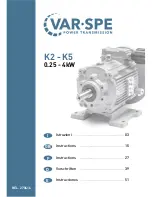
21
+
Adjusting the mixture control valve
If the engine hesitates, puffing out
a good deal of smoke, before
picking up to full speed, it is
probable that the idle mixture is
too rich.
1.
Fig.29
Mixture Control Screw
Screwdriver
Turn 30
In this case, it will be necessary
to turn the Mixture Control Screw
in the reverse direction from the +
mark (i.e. clockwise) to lean the mixture. About 1/12 turn
(30 ) should be sufficient (Fig. 29).
Alternatively, if the engine stops
or is slow to pick up speed,
without smoking or a strong
exhaust note, it is probable that
the idle mixture is too lean.
2.
Fig.30
Turn 30
In this case, it will be necessary
to turn the Mixture Control Screw
in the direction of the + mark (i.e.
counter-clockwise) approximately 1/12 turn (30 ) (Fig. 30).
Thirdly, if the rpm increases but the engine appears to run
with reduced power, it is probable that one of the cylinders
has ceased firing. You may detect this by the difference in
exhaust note and rpm compared with previous full-throttle
running. The cutting out of the cylinder may be caused by
the idle speed being set too low or the idle mixture being
too rich.
3.
In the case of the idle speed being too low, re-set the idle
position a little higher by means of the throttle trim on the
transmitter. In the case of the idle mixture being too rich,
turn the Mixture Control Screw in the reverse direction
NOTE:
As this is four-cylinder four-stroke-cycle engine, firing
strokes occur every half revolution (180 ), that is, two
firings take place every one complete revolution.
Therefore, at first you may have an impression that the
engine is idling at higher r.p.m. than actual running r.p.m.
It is recommended to check the engine r.p.m. with a
tachometer.
Changing the make of glowplug or fuel may sometimes
require re-adjustment of carburetor throttle.
Realignment of mixture control screw
In the course of making carburetor adjustments, it is just
possible that the Mixture Control Screw setting may be
upset.Its basic setting can be re-established as follows:
of the + mark about 1/12 turn (30 ). Normal safe idle
speeds are in the region of 2,000 r.p.m..
Fig.31
Fig.32
With the basic position of
the screw, this pin is located
at the center.
(The pin is seen if the
throttle lever is removed.)
mark
Throttle lever
Carefully turn the screw in the
direction of the + mark with
the screw-driver supplied until
it stops, then turn back again
exactly two turns.
NOTE:
If an on-board glowplug re-heat system is installed,
mixture adjustment at idle speed should be carried out
with this in operation.
22
FLIGHT
It is necessary to warm up the engine as with a full-size
aircraft or automobile. Do not attempt to take-off immediately
after the engine has been started. Allow the engine to run at
full throttle for at least 10 seconds before releasing the
model.
Checking before flight
Make sure that all four cylinders are firing.
Make sure that engine runs steadily at idle speed.
Make sure that engine is fully warmed up.
CARE AND MAINTENANCE
To ensure that you obtain long life and peak performance from
your engine, observe the following
Avoid running the engine under dusty conditions. If
necessary, lay a sheet of plywood or hardboard in front and
under the nose of the model when starting the engine.
1.
Foreign matter in the fuel can cause the carburetor jet to be
partially clogged.
2.
Therefore:
rinse out the fuel tank with methanol or fuel before
installing it
Install a fuel filter in the fuel delivery tube between tank
and carburetor
Install a fuel filter to pump inlet of the manual or electric
fuel pump
do not leave your fuel container open needlessly
check filters periodically and clean them when necessary
Do not close the needle-valve to too "lean" a setting. This
will cause the engine to overheat and slow down and also
will generate much nitromethane oxide due to extremely
high temperature which will cause internal rusting of the
engine. Always adjust the needle-valve very slightly to the
"rich" side of the peak r.p.m. setting.
3.
Clean the exterior of the engine with a clean cotton cloth. If
this is not done, oil and dirt will burn onto the outside of the
engine each time it is run and the engine will soon become
blackened
4.
If the engine is not in use for a while (more than two months)
remove the glowplugs and rinse out the interior with
kerosene (not gasoline), by rotating the crankshaft. Shake
out residue, then inject corrosion-inhibiting oil (preferably) or
light machine-oil through the glowplug holes and breather
hole, again rotating the shaft to distribute the protective oil to
all working parts.
5.
Fig.33
Silicone tubing
Breather nipple
Corrosion-inhibiting oil



































